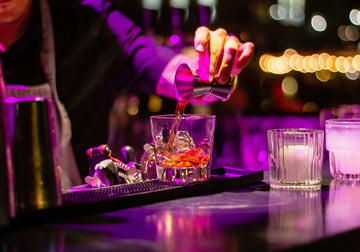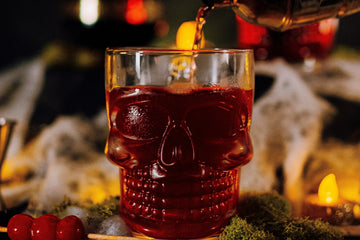
How Is Gin Different From Whiskey?
Gin and whiskey have been some of the most popular and widespread distilled spirits in the UK for centuries. Both are perfect as base spirits for cocktails and are also widely enjoyed drinking neat, to really appreciate their deep and complex characteristics.
Despite their similarities, gin and whiskey are two spirits that are distinct from each other in a variety of ways, including production process, ingredients, flavour profiles, historical background, and more.
How is the distillery process for gin different from whiskey?
Whilst both are made from grains such as barley, wheat, corn, or rye, these ingredients are processed differently to make their respective spirit.
For gin, the ingredients are flavoured with botanicals. The most notable botanical is juniper berries, but other botanicals such as coriander, citrus peel, cinnamon, anise, and angelica root are also used as well.
The botanicals are usually placed in the still during the distillation process, allowing the alcohol vapors to pass through them and flavour the gin. Once the distillation process is complete, the gin is often diluted with water to achieve the desired alcohol content and then bottled. To find out more about the distillery process of gin, read our How is gin distilled blog.
The grains in whiskey are usually mashed, fermented, and then distilled. Unlike gin, whiskey then goes through a long aging process in wooden barrels (typically oak), which flavours the spirit over time.
Flavour profiles of Whiskey vs Gin
Traditional gin typically has a well-balanced fresh, herbal aroma with notes of juniper and other botanicals. Flavoured gin has also become very popular in recent years, the most notable one being pink gin.
The flavour of pink gin differs from traditional gin but still has that notable fresh and herbal flavour to it. To learn more about the ingredients and taste profile of pink gin, read our How to make pink gin guide.
The flavour profiles of Whiskey vary depending on the type of whiskey, such as Scotch, Irish, or Bourbon. Generally speaking, compared to gin, whiskey contains more oak, caramel, and smoky notes.
Overall, whiskey tends to have a richer, more complex flavour when compared to gin, which is typically lighter and fresher. Some categorise whiskey as more of a ‘winter drink’, due to its warm notes and presence in a lot of hot alcoholic beverages.
Gin on the other hand is sometimes considered a ‘summer drink’. This is due to its light and crisp qualities, and its popularity served with ice and summer fruits, such as strawberries and blueberries.
The Origins of Whiskey
The origins of whiskey date back several centuries, and the exact origins of it are something that is often up for debate.
It is widely believed that whiskey was brought to Scotland and Ireland by monks around the 4th and 5th centuries. It was originally used for medical purposes, including soothing coughs, colds, and rashes. From there, it soon transformed into the beloved spirit that we still enjoy to this day.
The Origins of GinGin is a slightly more modern spirit, with its origins tracing back to the 17th century. Similar to Whiskey, it was also originally used for medical purposes. The Dutch used it as a medical tonic to treat similar symptoms as whiskey.
The spirit slowly made its way to England, where English distillers simplified the recipe and increased the juniper flavouring, evolving it into the gin we know today.
The Ageing Process: Gin Vs Whiskey
A spirit’s aging process plays a significant part in its final flavour. One of the deciding factors between whiskey and gin is how they go through the ageing process, this plays a significant part in their final flavours.
Whiskey is known for its complex aging process, as it is aged in oak barrels that impart rich flavours like vanilla, caramel, and spices. This helps add depth and richness to the spirit.
The aging period varies depending on the whiskey. Scotch whiskey is aged for at least 3 years, whereas many premium whiskeys are aged for much longer. The oldest whiskey in the world was aged for 81 years before bottling!
Gin on the other hand usually skips the prolonged aging process, focusing instead on botanicals for its flavour. There is however a type of gin known as ‘yellow gin’, which is aged for a brief period before being bottled (usually somewhere between a few months, to a few years).
Gin that goes through this short aging process has a subtle woody undertone that regular gins don’t have. Aging gin this way gives it a unique yellow or golden colour, hence the name ‘yellow gin’.
FAQs: Gin vs Whiskey
Both Gin and Whiskey contain around the same amount of calories (around 70 calories per shot). Which one is ‘healthier’ largely depends on how you consume it and what you mix it with.
Gin is frequently mixed with tonic water or lemonade, which can add significant calories and sugar. A better alternative would be to drink gin with sparkling water, or a squeeze of citrus fruit such as lemon or lime.
There are no additional calories in whiskey when consumed neat or with water, but a significant amount of calories are added when Whiskey is consumed with cola or added syrups in Whiskey-based cocktails.
Gin and Whiskey should both be consumed in moderation, but drinking the spirits neat or with a minimal amount of added sugar is the best way to cut calories from the drinks.
Should you drink gin and whiskey from the same type of glass?Gin and Whiskey are traditionally enjoyed in different types of glasses, which enhance and complement their unique flavours.
Whiskey is often served in a short glass known as an ‘Old Fashioned Glass’. These typically hold only 7-12 ounces and are most commonly used when serving Whiskey ‘on the rocks’ or neat.
Gin is typically served in either a Copa Glass or a Stemless Gin Glass. These are both large, bowl-like glasses that allow the aromas of your gin to breathe, as well as having room to add ice and garnish.




